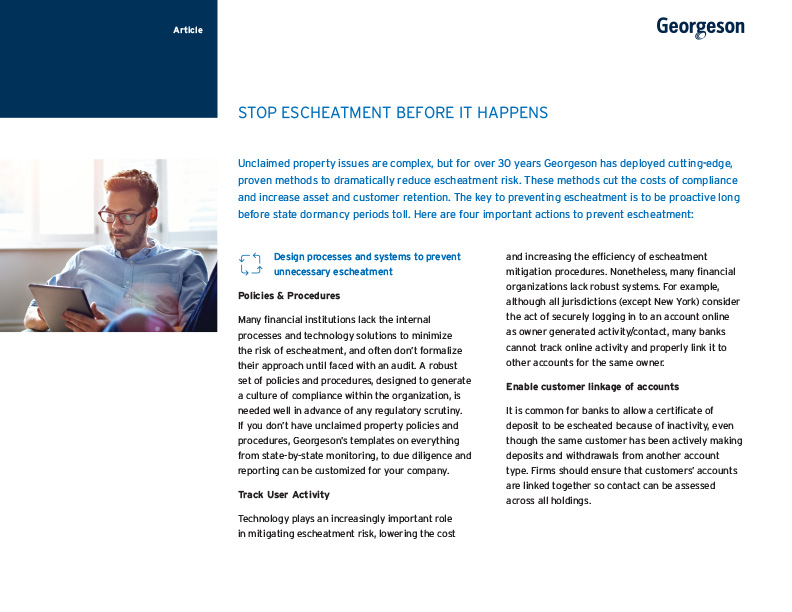Unclaimed property issues are complex, but for over 30 years Georgeson has deployed cutting-edge, proven methods to dramatically reduce escheatment risk. These methods cut the costs of compliance and increase asset and customer retention. The key to preventing escheatment is to be proactive long before state dormancy periods toll. Here are four important actions to prevent escheatment:
1. Design processes and systems to prevent unnecessary escheatment
Policies & Procedures
Many financial institutions lack the internal processes and technology solutions to minimize the risk of escheatment, and often don’t formalize their approach until faced with an audit. A robust set of policies and procedures, designed to generate a culture of compliance within the organization, is needed well in advance of any regulatory scrutiny. If you don’t have unclaimed property policies and procedures, Georgeson’s templates on everything from state-by-state monitoring, to due diligence and reporting can be customized for your company.
Track User Activity
Technology plays an increasingly important role in mitigating escheatment risk, lowering the cost and increasing the efficiency of escheatment mitigation procedures. Nonetheless, many financial organizations lack robust systems. For example, although all jurisdictions (except New York) consider the act of securely logging in to an account online as owner generated activity/contact, many banks cannot track online activity and properly link it to other accounts for the same owner.
Enable customer linkage of accounts
It is common for banks to allow a certificate of deposit to be escheated because of inactivity, even though the same customer has been actively making deposits and withdrawals from another account type. Firms should ensure that customers’ accounts are linked together so contact can be assessed across all holdings.
2. Educate and build customer awareness of the need to maintain contact
Helping your customers understand the importance of accurate contact information and regular activity will prevent accounts from becoming dormant. Customer awareness campaigns can include:
- Providing your customers with educational information at the time of account opening. This can be one of the best times to educate them.
- Including messages on online and printed customer communications. Include examples of what kind of information this could include.
- Establishing online alerts if mail has been returned as undeliverable when the customer logs into their account. This will help alert the customer to the problem more quickly and the address can be updated before the customer is at risk of escheatment.
- Training your staff about the risks of escheatment will ensure operations and customer service teams are well versed about unclaimed property compliance, enabling them to guide and inform customers appropriately.
3. Proactively identify customers at risk for escheatment
All jurisdictions except Puerto Rico have basic due diligence requirements that require banks to make a final attempt to contact owners of dormant accounts and uncashed checks towards the end of the dormancy period.
There are several steps that can be taken to identify customers at risk of escheatment:
- Monitor which accounts have been inactive for 12 to 18 months and note the relationship with these customers.
- Begin outreach campaigns early, rather than waiting until the mandated due diligence process needs to begin. Depending on the state dormancy period, financial organizations can then prioritize their outreach efforts. Allowing sufficient time for communication will improve your success in retaining these customers.
- When reviewing customer accounts, financial organizations should also be on the lookout for deceased customers that appear to be active. This often happens when family members are not aware of the account, or overlook paperwork when settling an estate. Identifying and assisting the correct legal claimants requires research, time and effort. However, financial organizations that do connect with the new beneficiary or representative often learn that they can generate valuable goodwill and potentially preserve the relationship with the original owner’s family.
4. Communicate early, often and effectively with at-risk customers
The due diligence process typically involves sending a single mailing to the dormant account owner’s last address, often during the last few months before escheatment, in hopes that they will respond and update their account. Most jurisdictions do not require due diligence mailings if the address on the account has been deemed inaccurate. While this bare-minimum approach meets regulatory requirements, it is not very effective in reconnecting owners with their assets.
Because the due diligence process generally occurs late in the dormancy period, the account owners have often been dormant for three to five years. This makes it difficult to find and communicate effectively with them. Given the late stage of the process, owners that do receive and open the mailing may miss the window to reactivate their account if they do not act immediately. Due diligence letters are only required to be sent once, and can easily be lost or missed in a household’s incoming mail. These letters are often perceived as potential scams because the customer does not perceive themselves to be inactive or lost.
To communicate effectively with at risk customers:
- Use colored envelopes and company logos in your communications. This will increase the response rate of due diligence and outreach mailings.
- The most effective means of reaching a customer and explaining the situation is through a one-to-one telephone conversation before the financial organization incurs the expense of a due diligence mailing.
- Direct mail programs can complement telephone outreach or serve as moderately effective campaigns on their own when time, budget, resources or the volume of accounts prevent telephone efforts. Varying communication techniques and changing the appearance of each mailing will also accelerate and increase overall response, as will customizing the specific details of the communication to the customer’s unique situation. Proper documentation is critical and correspondence should be retained in your files for control and audit purposes.
Georgeson’s unclaimed property services cover the unclaimed property lifecycle, relieving organizations of these complex and resource intensive task and providing a comprehensive roadmap to ongoing compliance.
Contact us
Learn more about how we can help your financial organization reduce escheatment.
